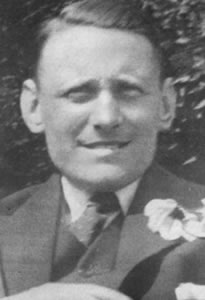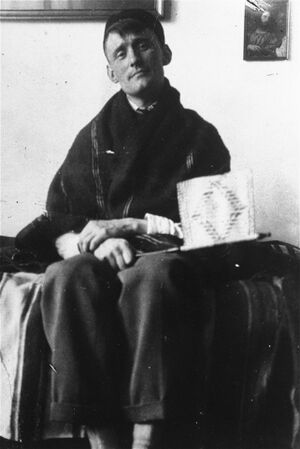Willem Arondeus facts for kids
Quick facts for kids
Willem Arondéus
|
|
|---|---|
 |
|
| Born |
Willem Johan Cornelis Arondéus
22 August 1894 Naarden, Netherlands
|
| Died | 1 July 1943 (aged 48) Haarlem, Netherlands
|
| Cause of death | Execution by firing squad |
| Citizenship | Dutch |
| Occupation | Artist, writer |
| Known for | Member of the Dutch Resistance |
|
Notable work
|
Matthijs Maris: de tragiek van den droom ('The Tragedy of the Dream') |
Willem Johan Cornelis Arondéus (born August 22, 1894 – died July 1, 1943) was a Dutch artist and writer. He became a hero during World War II by joining the Dutch anti-Nazi resistance movement. He took part in a brave plan to bomb a public records office in Amsterdam. This action aimed to stop the Nazis from finding Dutch Jews and others they wanted to arrest.
Arondéus was captured and executed shortly after his arrest. Later, Yad Vashem honored him as a Righteous Among the Nations. This special title is given to non-Jews who risked their lives to save Jews during the Holocaust. Before his execution, Arondéus made a powerful statement. He wanted people to know that those who are different are not weak or afraid.
Contents
Early Life of Willem Arondéus
Willem Johan Cornelis Arondéus was born in Naarden, a town in the Netherlands. He was the youngest son of a fuel trader from Amsterdam. Willem started his career as an artist. He worked as an illustrator, designing posters and tapestries. He also painted.
In 1923, he was asked to paint a large mural for Rotterdam City Hall. During this time, he also created illustrations for poems by famous Dutch writers. He looked up to an older Dutch designer named Richard Roland Holst. You could see Roland Holst's influence in Willem's art. Willem was not very famous and often lived without much money.

Around 1935, Willem stopped focusing on visual arts. He then became a writer. He had written poems and stories in the 1920s, but they were not published. In 1938, he published two novels: Het Uilenhuis ('The Owls House') and In de bloeiende Ramenas ('In the Blossoming Winter Radish'). He even drew the pictures for his own books.
In 1939, his book Matthijs Maris: de tragiek van den droom ('The Tragedy of the Dream') came out. This book was a biography about the painter Matthijs Maris. Two years later, he published Figuren en problemen der monumentale schilderkunst in Nederland. By this time, Arondéus was already involved in the Dutch resistance movement.
Joining the Dutch Resistance
In 1942, Arondéus started a secret newspaper called Brandarisbrief. In 1943, his newspaper joined forces with another publication called De Vrije Kunstenaar. Through this merger, Arondéus met Gerrit van der Veen. Van der Veen was the editor of De Vrije Kunstenaar.
In the resistance, van der Veen was skilled at making fake identity cards. Arondéus also became involved in creating these forged documents. Another brave resistance member, Frieda Belinfante, helped with this work.
A big problem for these fake documents was the Municipal Office for Population Registration. This office had real lists of people. The Nazis could check the fake IDs against these lists. This made the forged documents less useful. Arondéus, van der Veen, and their friends came up with a plan. They decided to destroy the registration office.
The Amsterdam Records Office Attack
Their attack happened on March 27, 1943. It was a risky mission. They managed to destroy 800,000 identity cards. This was about 15% of all the records. They also took 600 blank cards and 50,000 guilders. The building was blown up, and no one was caught that night.
However, someone betrayed the group. Arondéus was arrested on April 1, 1943. He bravely refused to give up the names of his team members. But his notebook was found. Because of this, most of the group were also arrested. Frieda Belinfante was the only one from the group who survived. She had to pretend to be a man and go into hiding.
On June 18, 1943, Arondéus was put on trial. He and 13 other men who took part in the attack were sentenced to death. Two of the group were spared, but the others were executed on July 1, 1943. Arondéus took full blame for the attack. This might be why two young doctors in the group were saved from execution. They received prison sentences instead.
Before he was executed, Arondéus made sure his message would be heard. He asked a friend or his lawyer to share his final words. He wanted people to know that courage comes in many forms. He said, "Tell people that those who are different are not weak."
Willem Arondéus's Legacy
After the Netherlands was freed in 1945, Arondéus's family received a special medal. The Dutch government gave it to them in his honor. In 1984, he was given the Resistance Memorial Cross. This award recognized his bravery in the resistance.
On June 19, 1986, Yad Vashem recognized Arondéus as Righteous Among the Nations. This is a very important honor. It means he risked his life to help Jewish people during the Holocaust.
In 2023, the English actor Stephen Fry made a TV show about Arondéus and Belinfante. The show, called Willem & Frieda, told the story of their wartime resistance work.
Images for kids
See also
 In Spanish: Willem Arondeus para niños
In Spanish: Willem Arondeus para niños









